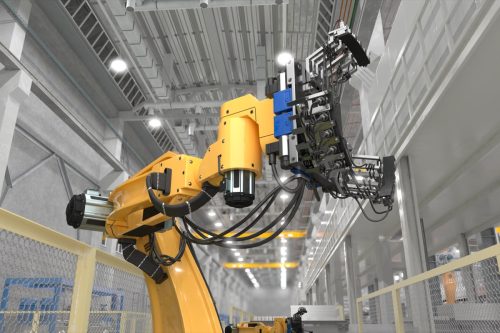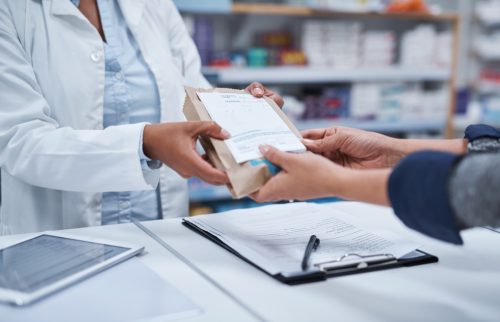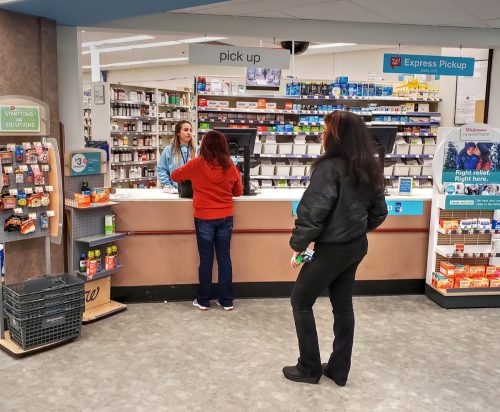If You Get Your Prescriptions at Walgreens, Prepare for This Big Change

Those of us who take daily medication have spent our fair share of time in pharmacies like Walgreens. Whether that’s your preferred pharmacy or not, Walgreens is everywhere: About 78 percent of the U.S. population lives within five miles of one of this company’s nearly 9,000 drug stores. It’s no surprise then that Walgreens filled around 827.5 million prescriptions in 2021 alone. But if you depend on this pharmacy for your medication, you should prepare for a major change that’s currently in the works—Walgreens just announced that it is planning to switch up its prescription process. Read on to find out what might be different soon.
RELATED: Walgreens Shoppers Are Outraged About This Major Change to Stores.
Walgreens is opening up new prescription fulfillment centers with robots.

Your next prescription may get filled by the bright, yellow arms of a robot. Walgreens is planning to open automated, robot-powered fulfillment centers across the U.S. to help aid the company in processing prescriptions for customers, CNBC reported on March 30. The company says it will open a total of 22 of these centers serving more than 8,500 of its nearly 9,000 U.S. stores over the next three years.
These facilities move pill bottles and caps through a highly automated assembly line, where they end up in customer-marked prescription bags that are grouped and sent to various pharmacy locations in different states. That means you will still pick up your medication at your local Walgreens store. According to CNBC, the change to this automated system may only be noticeable to customers through slightly different packaging.
This could help your prescription get filled faster.

Walgreens already has one of these facilities in the Dallas, Texas, area, CNBC reported. According to the news outlet, robots fill thousands of prescriptions here for customers who take medications to manage or treat high blood pressure and diabetes, among other conditions. And it actually is significantly faster than what is being done at typical Walgreens pharmacies. The company said that each robot can fill 300 prescriptions in just one hour, which is roughly the same amount that a regular Walgreens pharmacy with a handful of staff can do in an entire day.
RELATED: For more up-to-date information, sign up for our daily newsletter.
Walgreens said this will help its pharmacists have time for other services.

Rick Fernandez, a regional health care director for Walgreens in the Dallas area, told CNBC that the pandemic highlighted how pharmacists could be used in other ways. “It’s kind of dreary to be filling scripts all day long,” he explained. “What we were hearing was pharmacy was more of an asset that people gave us credit for.”
The arrival of these automated fulfillment centers will help free up pharmacists’ time and allow them to focus more on providing health care to customers, Walgreens CEO Roz Brewer told CNBC. “We’re doing all of this work, so that the pharmacist has an easier job, so that they can get back to being front and center, building a relationship with that patient and interacting the way they were trained—the work that they love to do,” she said.
Walgreens President John Standley said that some of the other duties pharmacists can take on instead of filling prescriptions include testing and treating medical conditions like strep throat or the flu, and writing prescriptions for people at risk of HIV. In Ohio, Walgreens pharmacists working as part of a pilot program are currently counseling and managing care for patients with asthma and chronic obstructive pulmonary disease (COPD).
The company is planning to expand these fulfillment centers over time.

Alongside the Dallas facility, Walgreens has already opened two other centers near Phoenix and Memphis. But that is just the beginning. Rex Swords, Walgreens’ group president of centralized services, operations and planning, told CNBC that by 2025, as much as half of the company’s prescription volume from stores could be filled at its robot fulfillment centers.
And while the company’s robot-powered center in the Dallas area currently fills about 35,000 prescriptions every day, that number will increase to as many as 100,000 prescriptions daily over time, Swords said. He added that another area of growth on the “program’s roadmap” is having these facilities fill direct mail prescriptions.